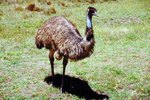
Though some contend that corn snakes derive their name from the similarity of their ventral scales to maize, others believe it reflects their preference for living in corn fields, where they feast on the plentiful rodents. In either case, the snakes are very beneficial for humans, as they adapt to disturbed habitats and keep rodent populations in check. Fortunately for humans, corn snakes are prolific animals, and most females lay large clutches of eggs each summer.
Corn Snake Basics
Corn snakes live throughout the eastern and southeastern United States. Adaptable animals and skilled climbers, corn snakes are common in forests, farms and suburban areas. Though they may occasionally exceed 5 feet, most adult corn snakes are about 4 feet long. They have flexible diets, but primarily consume birds and rodents as adults; juveniles consume lizards and frogs.
Average Clutches
Female corn snakes typically deposit about 12 eggs in a secluded space, such as a rotted log or tree stump. Small, young, old or thin females may produce clutches of two or three eggs, while large, well-fed females in their reproductive prime may deposit clutches of 34 eggs or more. Corn snake eggs are about 1 1/2 to 2 1/2 inches in length, and about 1/2 to 1 inch in diameter. Egg laying typically occurs in the late spring or early summer, with hatching occurring in the late summer or early fall.
Factors Affecting Clutch Size
Food availability affects the reproductive efforts of corn snakes. In years with unusually high prey abundance, female corn snakes produce larger clutches. In lean years, the snakes produce smaller clutches, or fail to reproduce at all. In both cases, the size of the young remains constant, it is the number of eggs that varies. This implies that the size of the young is very important, and they must be larger than a critical minimum size to have a good chance at survival.
Second Clutches
Because they have access to nearly unlimited food, captive female corn snakes sometimes produce a second clutch of eggs shortly after their first. The second clutch is typically much smaller than the first, and is very taxing on the female’s body. The developmental timing of both clutches is similar: Females deposit eggs about one month after mating, and the eggs incubate for about two to three months before hatching.
Gender Determination
While the incubation temperature surrounding the eggs determines the gender of many reptiles -- including most crocodilians, turtles, tortoises and geckos -- snakes determine their gender with their chromosomes, as mammals and birds do. However, differing from humans, females are the heterogametic sex: Male corn snakes always contribute a Z chromosome, while females contribute either a Z or a W.
References
- Animal Diversity Web: Pantherophis Guttatus
- Savannah River Ecology Laboratory: Corn Snake (Elaphe [Pantherophis] Guttata)
- Herpetology: An Introductory Biology of Amphibians and Reptiles; Laurie J. Vitt and Janalee P. Caldwell
- Bowling Green State University: Elaphe Guttata Guttata
- Functional Ecology: An Experimental Study of the Trade-Offs Between Age and Size at Maturity: Effects of Energy Availability
Photo Credits
-
NA/PhotoObjects.net/Getty Images




